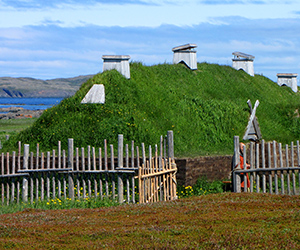CANADA HISTORY - Politics-Provinces
Prince Edward Island
The history of Prince Edward Island (PEI) is a story deeply rooted in the land and sea, stretching back thousands of years before European settlement. The Mi’kmaq people, who were the island’s original inhabitants, called it "Epekwitk," meaning "cradled on the waves," a reflection of the island's connection to the ocean that surrounds it. For the Mi’kmaq, the island was a rich source of sustenance, its forests filled with game and its waters abundant with fish and shellfish. Their way of life, based on seasonal migration and an intimate knowledge of the environment, was intricately tied to the rhythms of the land and sea, and they maintained a sophisticated culture that included trade with other Indigenous nations throughout the Maritimes and beyond.
The arrival of European explorers in the 16th and 17th centuries, beginning with the French, marked a significant shift in the island's history. French settlers named the island Île Saint-Jean, and it became part of the larger colony of Acadia. The French established small settlements, and the island's fertile soil made it a valuable agricultural outpost. However, the island’s position in the Gulf of St. Lawrence also made it strategically important in the broader imperial struggle between France and Britain for control of North America. This rivalry would come to define the island’s early history.
During the 18th century, Île Saint-Jean was drawn into the larger conflicts between France and Britain, particularly during the War of the Austrian Succession and the Seven Years’ War. In 1758, as part of Britain’s efforts to conquer New France, British forces seized control of Île Saint-Jean, and the island’s French population, along with the Acadians, suffered a fate similar to their counterparts in mainland Nova Scotia. Thousands of Acadians were deported from the island during the Grand Dérangement, the mass expulsion of the Acadian people, with many finding refuge in what is now Louisiana, while others perished or were scattered across the French and British colonies. This period of upheaval left a deep mark on the island’s cultural and demographic landscape.
Following the British conquest, the island was renamed St. John’s Island and became part of the British Empire. The British government sought to settle the island with Loyalists and other British subjects, and in 1767, the island was divided into large land grants, awarded to absentee landlords, many of whom never set foot on the island. This land tenure system would become one of the most contentious issues in the island’s history, as it led to widespread dissatisfaction among settlers who were forced to pay rent to landlords who lived in England. The legacy of absentee landlordism created economic and social divisions that would persist well into the 19th century.
St. John’s Island was granted colonial status in 1769, separating it from Nova Scotia and giving it a degree of political autonomy. However, it wasn’t until 1799 that the island was renamed Prince Edward Island in honor of Prince Edward, Duke of Kent, the father of Queen Victoria. Throughout the late 18th and early 19th centuries, PEI’s economy remained largely agricultural, with its fertile red soil well-suited to farming. The island became known for its wheat, potatoes, and other crops, which were exported to markets in the Maritimes and New England.
The 19th century was a period of both economic growth and political struggle for Prince Edward Island. The island’s population grew steadily, bolstered by waves of Scottish, Irish, and English immigrants, many of whom were tenant farmers. However, the issue of land ownership continued to dominate island politics. The tenant farmers, who made up the majority of the population, resented the absentee landlords and demanded reforms that would allow them to own the land they worked. The Land Question became the central political issue of the time, with movements such as the Escheat Party advocating for the expropriation of land from absentee landlords and its redistribution to settlers. This political struggle culminated in the passage of the Land Purchase Act of 1875, which allowed the provincial government to buy out the absentee landlords and sell the land to the farmers, finally resolving the issue that had plagued the island for over a century.
Prince Edward Island’s political development also took shape during this period. In the early 19th century, the island’s colonial government was dominated by a small elite, but political reforms gradually expanded the franchise and increased representation for the island’s rural population. The formation of political parties, such as the Liberal and Conservative parties, reflected the growing political engagement of the island’s inhabitants. PEI’s entry into Confederation, however, was far from straightforward. The island was a reluctant partner in the discussions that led to the formation of Canada in 1867. In fact, the famous Charlottetown Conference of 1864, which laid the groundwork for Confederation, was originally intended to discuss the unification of the Maritime provinces, and PEI’s delegates remained skeptical of joining a larger Canadian union.
PEI’s initial refusal to join Confederation was based on fears that the island’s interests would be overshadowed by the larger provinces of Ontario and Quebec. However, mounting financial difficulties, particularly the cost of building and maintaining a railway, eventually forced the island to reconsider. In 1873, facing economic collapse, Prince Edward Island agreed to join Confederation in exchange for the federal government assuming its railway debt and providing a continuous ferry service to the mainland. This marked a turning point in the island’s history, as it became Canada’s smallest province, both in size and population.
Throughout the late 19th and early 20th centuries, PEI’s economy remained largely agricultural, with potatoes becoming the island’s signature crop. Fishing, particularly for lobster, also became an important industry, while shipbuilding flourished for a time, driven by the island’s abundant timber resources. However, as wooden ships were replaced by steel, the island’s shipbuilding industry declined. The 20th century brought significant changes to the island’s economy and society. The construction of the Confederation Bridge, which opened in 1997, provided a direct link to the mainland, transforming transportation and commerce for the island’s residents. Tourism also became an increasingly important part of the economy, with the island’s picturesque landscapes, historic sites, and literary connections—particularly to Lucy Maud Montgomery’s Anne of Green Gables—drawing visitors from around the world.
Politically, Prince Edward Island has maintained a tradition of small-scale, community-focused governance. Its political landscape has been dominated by the Liberal and Conservative parties, with governments alternating between the two for much of the province’s history. Notable political figures include Joseph Hensley, a key figure in the movement for land reform, and Sir Robert Borden, a PEI-born lawyer who went on to become Prime Minister of Canada. The island’s political culture has often been characterized by a focus on local issues, with agriculture, fisheries, and rural development playing central roles in the province’s political discourse.
Today, Prince Edward Island stands as a province that has embraced both its agricultural roots and its modern identity as a tourism and cultural hub. The island’s people, known for their strong sense of community and connection to the land, have navigated centuries of economic and political change while maintaining a distinct identity within Canada. From the early days of Mi’kmaq stewardship to the political struggles of the 19th century and its role in the formation of Confederation, PEI’s history is a testament to the resilience and determination of its people. Its leaders, from tenant farmers advocating for land rights to politicians negotiating the island’s place within Confederation, have helped shape a province that remains, in many ways, the cradle of Canada’s nationhood







.jpg)




